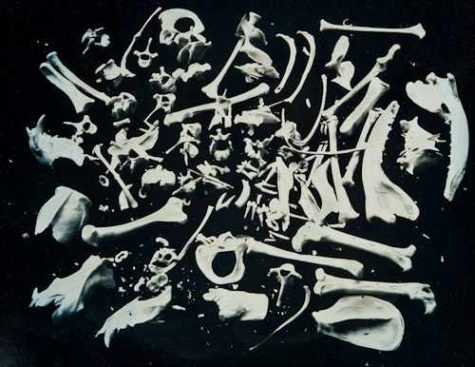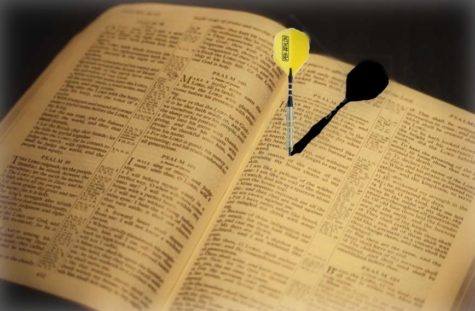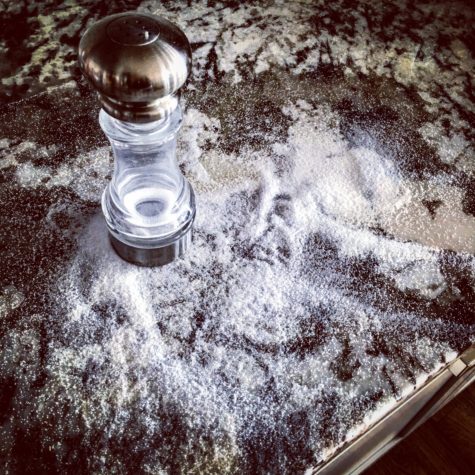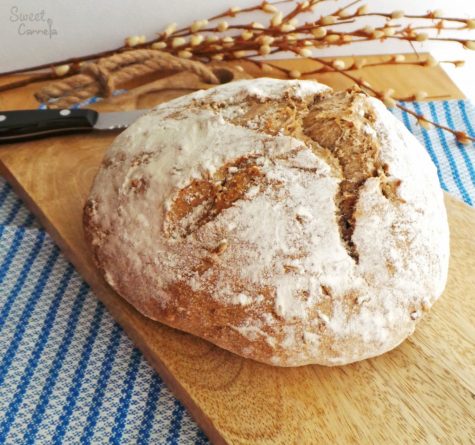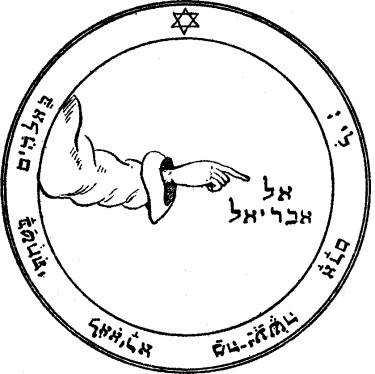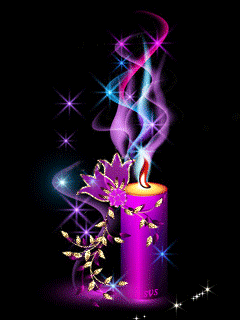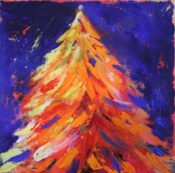Methods of Divination
Reading Possum Bones
This I have never seen done, only heard it described by an African-American woman born in Tennessee whose grandfather did it, circa 1945-50, when he was very old and she was young. She told me that he would only read the bones outdoors in the yard, sitting on the dirt and throwing them into a circle drawn in the dirt.
She asked me if I knew enough about reading possum bones to refresh her childhood memories of her grandfather’s method, but alas, I did not; however, according to Eoghan Ballard of the University of Pennsylvania, this woman’s grandfather was throwing the bones according to a system used by Bantu people throughout Southern Africa; the bones are usually knuckle bones, marked with dots and crosses.
The reading of knuckle bones led, quite naturally, to the use of dice in divination, and in America dice reading, especially when performed according to one of the popular 19th century French methods, has more or less replaced reading the bones among African-Americans.
Source: Lucky Mojo
Throwing The Bones
In bone divination, bones of various sorts are ritually tossed onto a mat, an animal hide, or into a circle drawn in the dirt, and the resulting patterns interpreted.
Throwing the bones is an ancient practice traditional to many regions of the world, including Africa, Asia, and North America. The number and type of bones employed, as well as the inclusion of other small objects, such as pebbles, shells, and hard nuts, varies quite a bit from culture to culture.
In the traditions of some cultures, the bones, shells, and/or nuts that are to be thrown are left in their natural state; in other cultures they may be shaped and marked, much like dice, dominoes, or the cut cowrie shells used in Obi and Diloggun divination.
Marked bones are often used in groups of two or four to obtain yes or no answers, as well as more detailed information. There is quite a bit of evidence to support the idea that gaming dice, often casually called “the bones,” may have had their origin in marked bone divination, as there are still forms of divination in which the markings of the spots and dots on dice or dominoes are used to read fortunes for clients.
As a hoodoo practice, casting or throwing the bones has deep traditional roots in African culture, especially as developed among the sangomas or divining healers of the Zulu, Swazi, Xhosa, and Ndebele traditions in southern Africa. Trained as herbalists, spirit mediums, and diviners, they fulfill an important role in their culture, equivalent to that of a root doctor in the United States or an obeah practitioner in Jamaica.
Mingling of African traditions with Native American and European forms of divination have produced quite a lot of variation in hoodoo practices. Traditional items used by Southern-style hoodoo doctors and spirit-led fortune tellers who employ these ancient methods of divination include bones, stones, coins, stalks, or shells. Additionally, some who follow this style of divining with natural curios may also perform augury by inspection of natural botanical and zoological curios such as owl pellets.
According to Catherine Yronwode, a well known author and practitioner in the world of Hoodoo, there are three basic forms of bone divination:
- Heated and cracked bone reading:
a form of Pyromancy. Usually done by heating the shell of a turtle, ox scapulae, or turtle plastrons in fire and then interpreting the cracks that form. This began and was primarily practiced in ancient China, in the late Shang Dynasty. - Mathematical systems of bone reading:
Geomancy. An example of this is Hakata, a very interesting form of divination found in Africa, where one would interpret hand-made tablets by the markings inscribed there on. - Spirit-led interpretive bone reading:
Cleromancy. This is a Shamanic from of divination. It is used, and varies greatly, among many different cultures and beliefs. A wide array of animal bones are used in Shamanic bone reading. The bones carry different meanings and energies according to what animal they belonged to, and what type of bone it is (tooth, claw, hand bone, etc.)
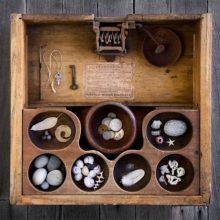 Although there is no single system of bone or curio divination used by all African American practitioners, some old-timers read a set of chicken bones or ‘possum bones, and do so only on the ground rather than a table-top, after the manner still practiced in Africa to this day. Others mix pebbles with their bones, as some sangomas do, and might read on a table-top — but no matter what natural curios are included, the practice is still called “throwing the bones.”
Although there is no single system of bone or curio divination used by all African American practitioners, some old-timers read a set of chicken bones or ‘possum bones, and do so only on the ground rather than a table-top, after the manner still practiced in Africa to this day. Others mix pebbles with their bones, as some sangomas do, and might read on a table-top — but no matter what natural curios are included, the practice is still called “throwing the bones.”
Hoodoo bone readers consider it traditional to keep their divination bones in a basket, bowl, or bag on or near their altar when not in use and to cast them out onto a mat, a hide, or a circle to read them, which are African techniques of working. Each bone may have a meaning, and the patterns among the bones may be significant as well.
For example, in one family tradition, nine chicken bones are used, and each bone has a meaning:
- wing bone signifies travel
- neck bone signifies poverty
- wish bone signifies good fortune
In addition to being used in rites of throwing, bones are also ritually manipulated in other ways for the purpose of telling the future for a client. For instance, they may be burned in a fire and the resulting chars and cracks examined in order to determine specific answers.
Bones, as well as other body parts, may also be used as a means to communicate mediumistically with the dead and with spirits, through psychometry.
Many diviners believe that one’s set of bones should be special and unique to the individual. You simply cannot go out and buy a bone divination set. Bones can be gathered, bought, obtained from different sources, but the completion of the set and power lay with the the individual’s personal contributions.
Practitioners of Hoodoo will use a wide array of bones along with artifacts or game pieces to represent a specific person. The Sangomas, an African people who greatly influence the Hoodoo tradition, believe that it is their ancestors speaking through the bones; so to aid in communication, will carry a porcelain doll head containing dirt from the grave site of the ancestral spirit they work with.
Among the Mongolians, four unmarked sheep knuckle bones are thrown, each of which has four distinguishable sides, which produces an array of 36 possible answers to any given question. The name for this system of divination is shagai, often rendered in English as “Complicated Fortune Telling.” In addition to functioning as a system of divination, shagai can also be played as a gambling game.
Source: Readers and Rootworkers and Mama Bee’s Blog
Nephomancy – What is it?
Nephomancy or Nephelomancy is divination by studying clouds. This involves observing and interpreting the color, shape and position of clouds in the sky. The Celtic Druids made extensive use of nephomancy, which they called neladoracht.
Celtic shamans sometimes practiced a form of Nephomancy that was closely related to Hydromancy and Scrying. After finding a hollowed stone or other depression that was filled with rain water, priests would look into it studying the cloud formations reflected on the water’s surface.
To practice Nephomancy today, one should ask specific questions and then observe the shape and disposition of the clouds. This is easy enough to do in most parts of the world and requires only a basic understanding of the forces involved.
Obviously to attempt the performing of Nephomancy you need a day when the sky is clear and cloudy, a day when the sky is sufficiently clear to define the shapes of the clouds.
Throughout history symbols of political or religious importance have been seen in the clouds. In A.D. 312 when Emperor Constantine was marching against the army of Maxentius at Rome, both he and his entire army saw a shining cross of light amid the clouds. It was said the cross contained the Greek words “By This Conquer”. Later that night Christ appeared to Constantine in his dreams bearing a cross in his hand ordering Constantine to have a military standard made in the same image. Under this standard his outnumbered army was victorious. Down through history entire military battles have been witnessed in the clouds.
A Medieval form of nephomancy involved summoning ghosts and specters to project images of future events onto clouds.
François de la Tour Blanche wrote that aeromancy (a form or nephomancy) was the art of fortune-telling when specters materialize in the air, possibly with the aid of demons, projecting images of the future onto clouds like a magic lantern.
Modern nephomancers observe the ever changing shapes of cloud formations as a form of meditation.
Bibliomancy – What is it?
Bibliomancy is a form of Stichomancy or Libromancy (“divination from lines”), which involves selecting a random passage from a random book of any nature. Bibliomancy and Stichomancy have been popular methods of divination for at least 3000 years, when the I Ching was first used to divine the future.
The method of employing sacred books (especially specific words and verses) for ‘magical medicine’, for removing negative entities, or for divination is widespread in many religions of the world.
According to the Oxford English Dictionary, the word bibliomancy “divination by books, or by verses of the Bible” was first recorded in 1753 (Chambers’ Cyclopædia). Sometimes this term is used synonymously with stichomancy “divination by lines of verse in books taken at hazard”, which was first recorded ca. 1693 (Urquhart’s Rabelais).
According to one source, the original use of Bibliomancy was a method to discover whether or not a person was innocent of sorcery. It consisted of weighing the suspect against the great Bible in the local church. If the subject weighed less than the Bible, he or she was considered innocent. Later, Bibliomancy became attached to any divinatory use of the Bible.
In medieval times it was believed that Bibles laid on a child’s head would induce sleep, and that reading from the Bible to a pregnant woman would give her a safe delivery.
Some Christian and Jewish groups believe that the Bible forbids divination in general, however, according to the Shulchan Aruch, it is not the sin to divine an answer using the “goral“, the practice of opening the Chumash to see an answer to a question, or asking a child for the first piece of scripture that comes to his mind.
Here’s how it works:
- A book is picked that is believed to hold truth.
- It is balanced on its spine and allowed to fall open.
- A passage is picked, with the eyes closed.
The name Rhapsodomancy has also been used for this practice, which involved opening the book at random and then interpreting the omens in a prophetic fashion, usually using the first words or sentences read. A historical precedent was the ancient Roman practice of sortes “divination by drawing lots” which specialized into sortes using the texts of Homer, Virgil, and the Bible.
St. Francis of Assisi, to seek divine guidance, is said to have thrice opened to a random page of the book of Gospels in the church of St. Nicholas. Each time he opened to a passage in which Christ told His disciples to leave their earthly belongings and follow Him.
In Iran, Bibliomancy using the dīvān of Hafiz is the most popular for this kind of divination, but by no means the only kind. The Qur’an, as well as the Masnawī of Rumi may also be used. Fāl-e Ḥafez may be used for one or more persons. In group bibliomancy, the dīvān will be opened at random, and beginning with the ode of the page that one chances upon, each ode will be read in the name of one of the individuals in the group.
The ode is the individual’s fāl. Assigning of the odes to individuals depends on the order in which the individuals are seated and is never random. One or three verses from the ode following each person’s fāl is called the šāhed, which is read after the recitation of the fāl. According to another tradition the šāhed is the first or the seventh verse from the ode following the fāl. An ode which had already been used for one individual in the group is disqualified from serving as the fāl for a second time.
Because book owners frequently have favorite passages that the books open themselves to, some practitioners use dice or another randomiser to choose the page to be opened. This practice was formalized by the use of coins or yarrow stalks in consulting the I Ching. Tarot divination can also be considered a form of bibliomancy, with the main difference that the cards (pages) are unbound. Tarot can also be considered a form of bibliomancy, with the main difference that the cards (pages) are unbound.
There is a prevalent practice among certain, particularly messianic, members of Chabad-Lubavitch Chasidic movement to use the Igrot Kodesh, a thirty-volume collection of letters written by their leader Menachem Mendel Schneerson for guidance.
Another variant requires the selection of a random book from a library before selecting the random passage from that book. This also holds if a book has fallen down from a shelf on its own.
English poet Robert Browning used this method to ask about the fate of his enchantment to Elizabeth Barrett (later known as Elizabeth Barrett Browning). He was at first disappointed to choose the book Cerutti’s Italian Grammar, but on randomly opening it his eyes fell on the following sentence: ‘if we love in the other world as we do in this, I shall love thee to eternity’ (which was a translation exercise).
Sources: Wikipedia and other sources
Alomancy – What is it?
Alomancy, also called Adromancy, ydromancie, idromancie, and halomancy, is an ancient form of divination.
Similar to many other forms of divination, the diviner casts salt crystals into the air and interprets the patterns as it falls to the ground or travels through the air. The diviner can also interpret patterns formed from the residue of a salt solution as it evaporates in the bowl. The exact interpretations are unknown, but it probably follows a similar method to aleuromancy.
It is this ancient divination science that accounts for some of our modern salt related superstitions, including the one about people saying that misfortune is about to fall on the household when the salt cellar is overturned, and the one about throwing a pinch of salt over someone’s shoulder for good luck.
A form of Alomancy consists on the casting of salt into a fire, and is considered a type of Pyromancy.
Source: Wikipedia
Alphitomancy – What is it?
Alphitomancy is an old old form of divination involving barley cakes or loaves of barley bread.
This is an ancient method of determining the guilt or innocence of a suspect person by feeding him or her a specially prepared wheat or barley loaf or cake. If the person suffers from indigestion, or finds the loaf to be distasteful, this is interpreted as a sign of guilt.
There was said to be near Lavinium a sacred wood, where Alphitomancy was practiced in order to test the purity of the women. The priests kept a serpent, or, as some say, a dragon, in a cavern in the wood. On certain days of the year the young women were sent thither, blind-folded, and carrying a cake made of barley flour and honey. The devil, we are told, led them by the right road. Those who were innocent had their cakes eaten by the serpent, while the cakes of the others were refused.
Source: Crystal Links
Aeromancy – What is it?
Aeromancy (from Greek aero, “air”, and manteia, “divination”) is the art of foretelling the future by the observation of atmospheric, air or sky phenomena. This goes beyond the range of weather forecasting, concentrating in such things as wind currents, cloud shape and formation, comets and falling stars, spectral formations, and other phenomena which are not normally seen or visible in the heavens. Even today such visions cause speculation and sometimes consternation among human viewers.
Due to the historical interest people have had in weather, seeing it as a medium by which the gods expressed both joy and anger towards those who worshiped them, it is no surprise that aeromancy is one of the oldest forms of divination. The Hindus, Etruscans, and Babylonians in particular found the signs in the sky to be of great interest and practiced forms of chaomancy and ceraunoscopy. This fascination with the omens in the skies was reflected by the gods worshiped by these peoples. Two gods associated with ceraunoscopy are:
- Tinia, the Etruscan god of lightning
- Adad, the Babylonian god of thunder, lightning, and prophesy
There are several types of divination that can be categorized under the term “aeromancy”:
- Austromancy, divination by observing the wind.
- Anemoscopy is austromancy in which the wind direction and intensity is interpreted.
- Cometomancy, divination by the appearance of comet tails.
- Ceraunoscopy, divination by the interpretation of thunder and lightning.
- Chaomancy, divination by aerial visions, is nearly synonymous with aeromancy, but most often refers to nephomancy or cometomancy.
- Meteormancy, divination by meteors and shooting stars.
- Nephomancy is divination by the interpretation of the movement of clouds.
Modern Aeromancy:
Some forms of modern aeromancy have taken a more introspective turn than their historical counterparts. For instance, modern nephomancy is a receptive, almost meditative process, by which a person is said to be able to examine their unconscious. The nephomancer studies the clouds, whose formations are random and constantly changing. The images and symbols the diviner picks out from the chaos are believed to have some sort of significance to the diviner, so long as he applies his own personal interpretations to the symbols, rather than those written or spoken about by another.
Source: Wikipedia
Notarikon
Notarikon (Hebrew: נוטריקון Noṭariqōn) is a method of deriving a word, by using each of its initial (Hebrew: ראשי תיבות) or final letters (סופי תיבות) to stand for another, to form a sentence or idea out of the words. Another variation uses the first and last letters, or the two middle letters of a word, in order to form another word. The word “notarikon” is borrowed from the Greek language (νοταρικόν)), and was derived from the Latin word “notarius” meaning “shorthand writer.”
Notarikon is one of the three ancient methods used by the Kabbalists (the other two are gematria and temurah) to rearrange words and sentences. These methods were used in order to derive the esoteric substratum and deeper spiritual meaning of the words in the Bible. Notarikon was also used in alchemy.
Here is an example:
First — write out your goal using as few words as possible; yet, keeping the focus clear. Here are a few examples:
- Answers come easily to me = ACETM if just using the first letter of each word.
- Psychic ability is my gift = PCAYISMYGT if using the first and last letters in each word.
- Wisdom is within me = DOISTHME if using the two middle letters in each word.
- I Understand What To Do = IUWTD if just using the first letter of each word
- The Path Ahead Becomes Clear = TEPHADBSCR if using the first and last letters in each word.
- Clarity Comes Quickly = AROMIC if using the two middle letters in each word.
The letters become a sigil of power that you can use in a variety of magickal applications. Only you know what the letters stand for; therefore, no one can destroy your intent with doubt. (Except you, of course.)
This type of sigil works well with other images. For example, you may wish to draw a circle around the letters and add pictures, other sigils such as an Ankh (life), a Pentacle (protection), or the Six-Rayed Star (manifestation). You may prefer to use appropriate colors in your design. Remember to write your full name on the reverse side of the talisman.
Your next step is to empower your Notarikon, and here are the guidelines (which of course, can be changed depending upon your training and your belief system):
- Always include and say aloud divinity during the activation.
- Always say aloud precisely what you desire and the power you are calling on.
- Always include and say aloud the element or elements pertaining to the request. (Example: By the Power of Great and Mighty Mars, Element of Fire…)
For example:
If you are a Pisces, or doing this ritual when the Sun or Moon is in Pisces, you can call upon the Spirit of the Universe (you can change this), by the power of Jupiter (which rules Pisces) and the element of Water. (Pisces’ element is water). Alternatively, you could call upon the power of The Invincible Sun and the element of Fire… etc. Think about this, and make it your own.
A Basic Ritual:
- Cleanse and create sacred space.
- Cast a circle if you like.
- Create your talisman.
- Bless it with a dab of holy water or oil.
- Call upon the Spirit of the Universe, by the power of (your choice) to: insert your desire here.
- As you do this, rub the talisman in your hands, then begin blowing on it softly, running the energy from the field of potential around you into the talisman.
- Rock back and forth if you like.
- Let the experience be free flowing.
- When you are finished (you’ve lost the thought), draw an equal-armed cross on the talisman to seal it and announce that it is sealed.
- Carry the talisman with you, place under a candle for further empowerment, or put in a conjuring bag until you desire has manifested.
- If you have called upon the element of water for assistance, when it is time to deactivate the talisman, put it under running water, see the light in your mind that is around the talisman dissipate, and then throw it away. For the element of fire, you might burn the talisman… etc.
Debbie: Reading Candle Wax
Bridget Grimes: 310112_svyatki2_500
Mari: Reading Candle Wax
Ali: Notarikon
ALI: Notarikon
